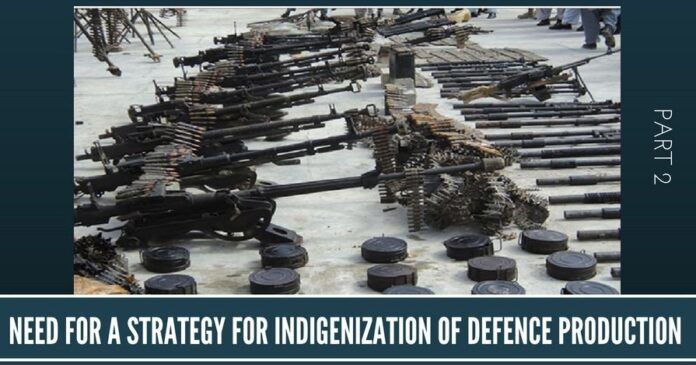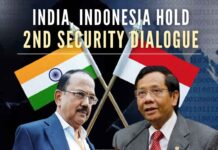
Part 1 of this series can be ‘accessed ‘ here. This is Part 2.
Of all the definitions of the word “strategy”, the one I like best is: An implementable long-term plan for achieving tangible and intangible objectives, with a clear understanding of who is to do what, how, why and in what timeframes.
An ideal strategy should address the following:
Who: The objective should be to engage all the stakeholders at the decision making level, in generating an actionable national policy document on this theme. In fact, there is no dearth of policy documents originating from various authorities, which are often at cross purposes. There are also innumerable position papers by reputed consulting organizations, defence analysts et al dealing with the subject.
Can their needs be satisfied without a comprehensive strategy for indigenization of defence production, and a critical re-look at the very functioning of our Defence PSUs and Ordnance factories?
Also, many of these policy statements and position papers are outdated in the light of current initiatives like “Make in India”, a creation of Skill Development sectors, revisions to DPP, raising of the cap on DFI in defence etc
What: Stemming from the above, the primary effort should be to elaborate the steps which need to be taken to liquidate the need gap. The time-tested method of analysis would be to draw up a multidimensional matrix, of technology needs, hardware and software needs, sources from where these needs could be met and changes which need to be incorporated into existing policy frameworks.
How: As in all domains of human endeavour, this is the tricky bit. Finding the resources to achieve self-sufficiency in the defence domain is difficult even in a resource-rich economy. Doing so in the Indian context, where there is a permanent debate on “guns versus butter” or defence versus development, the problem is even more acute.
The policy would need to discriminate between various types of technologies required for indigenous production, dumbing down from platform level to components and materials, the role of the private sector, need for human resource and skill development, the design and development effort, an economy of scales etc.
The strategy should also address the complaints now being expressed, particularly by the private sector of the complex bureaucratic processes, lack of financial incentives, lack of a ‘level playing field’ for all players, with the regulations loaded in favour of the public sector, insufficient involvement of the MSME sector etc.
Why: This is an equally important issue to be addressed in the strategy for indigenous defence production. As suggested in the proposed strategy for technology acquisition, it is important to substantiate why a particular subsystem, equipment, component, or material needs to be indigenized, and then allocate the necessary resources to accomplish the objective, irrespective of the cost of doing so.
Purpose
It would be stating the obvious that the strategy for indigenization for defence production should stem from an overarching national strategy for taking India into the higher echelons of the comity of nations of the twenty-first century. An element of that would be the national security strategy, an approach for which is outlined in other sections of this collection. From this should evolve the national defence strategy, in turn encompassing the Four pillars of Defence Capability.
People
Delving deeper both literally and figuratively into the world of submarines, it is believed that funds to the tune of INR 60,000 crores have been allocated for the Indigenous Submarine programme P75 I. Having had the experience of building submarines of our own of both German and French origin, not to mention the path-breaking design and construction of our own nuclear submarine with appreciable assistance from the Russians, should not P 75 I be a cakewalk?
But do we have the People at conceptual, directional and functional levels to launch and deliver this programme in a time-bound manner not only at the construction yard but at the myriad indigenous units of Tier 1, 2 and 3 equipment manufacturers, system integrators, vendors, etc? How about the Fifth Generation Fighter Aircraft programme? And what of the advances into the Integrated Guided Missile Programme?
Do we have the people? Do they have the skills? Are we retaining them? Most importantly are we motivating them to deliver at their optimum? Does each of this require a separate strategy? Or should this be part of the national strategy?
Processes
Reams of material are available commenting on the efficacy or otherwise of the Defence Procurement Policy and stemming from this the Defence Procurement Procedures. Special focus has also been directed towards the Offset clauses. Critics of the Defence Procurement Policy bring out various lacunae.
Suffice it is to say, that this can at best be Work in Progress at any stage, and many innovative changes have indeed been introduced. But like all WIP, there are miles to go.
Products
And finally the “products” of ‘indigenisation’ range from the complete weapon platform, as in ships, submarines, aircraft, armoured fighting vehicles etc, through the whole gamut of systems, subsystems, equipment, components, right down to nuts, bolts, washers, cables, material etc.
In the ultimate analysis, the shoe really pinches at the Field Army, in the ocean depths, in the skies, and not in South Block. Can their needs be satisfied without a comprehensive strategy for indigenization of defence production, and a critical re-look at the very functioning of our Defence PSUs and Ordnance factories? Can the formulation of this strategy be left to the Ministry of Defence performing the roles of Prosecutor, Defence and Judge?
The Way Ahead

The first step would be to constitute a Panel of Experts, who would carry out an in-depth analysis of the gap between what is needed and what is available, unlike the proverbial six blind men of Hindustan, describing an elephant, each viewing the problem from their respective perspectives. In the figure above, the six individuals could be taken to represent, the three End users, the MOD, Platform manufacturers and MSMEs.
Indigenisation of defence production is a must, and a comprehensive strategy for this needs to evolve. There are no shortcuts
The composition of the Panel
This would be the first proof of the willingness and ability of the decision makers to think “strategically”. Most panels are formed based, not on the expertise of the selected panel members, to “think out of the box”, but on titles, designations and positions held. Defence manufacturing is multi-functional, multi-level, and multi-locational. The proposed Panel of Experts for developing a Strategic Plan for indigenization of defence manufacturing should represent this pan-India and pan-Industry character.
The primary charter of the Experts panel should be to elaborate the steps which need to be taken to liquidate the need gap. The time-tested method of analysis would be to draw up a multidimensional matrix, of technology needs, hard and software needs, sources from where these needs could be met and changes which need to be incorporated into existing policy frameworks.
Time frames
The Expert panel should be tasked with two-time frames for generating the strategic plan in the first, the emphasis should be on when specific actions need to be taken and will form the yardstick for an effective monitoring system. In the second, the accent should be on time frames for various phases of the action plan to be achieved and would be useful in the review mechanism.
Most weapon platforms have a twenty-five-year life expectancy. Strategic plans should at least cater to fruition in half the time.
Conclusion
We are living in a complex world, in complex times. National security is of paramount importance to a nation with a burgeoning population, expanding the economy and a not too friendly neighbourhood. One of the components of the national security apparatus is the defence establishment, as opposed to restricting to the military.
As repeated in many forums, ad nauseam, it will behove a nation of our demographic mass, economic strength and military might in the 71st year of our Independence to rely on 70% of our military requirements to be imported, On the contrary, we must leverage our intellectual property, financial muscle, manufacturing capacity, and purchasing power for military equipment to imbibe and harness technology in such a manner as to make the transition from an importer to an exporter in the defence domain.
Indigenisation of defence production is a must, and a comprehensive strategy for this needs to evolve. There are no shortcuts.
Note:
1. The views expressed here are those of the author and do not necessarily represent or reflect the views of PGurus.











Great articles sir. I suggest you send them to the PMO.
pmopg. gov. in/pmocitizen/Grievancepmo.aspx